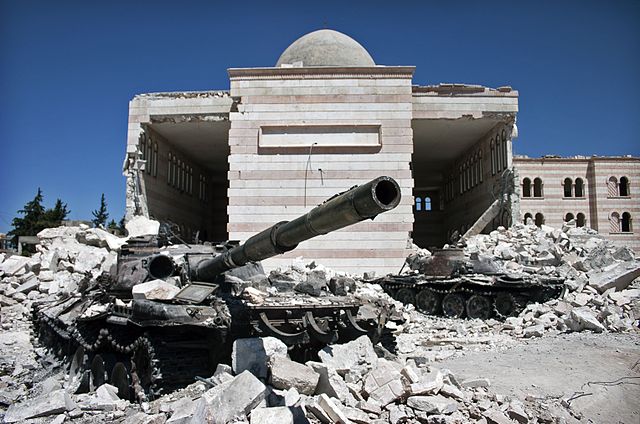Syrian President Bashar al-Assad was unaware of the coming inferno – one which would rage across North Africa and into the Middle-East, leaving in its wake an ash heap of the region’s most entrenched dictatorships – when the so-called “Arab Spring” reached the Syrian Arab Republic in 2012. Six governments would change hands in that tumultuous period, while the leaders of Tunisia, Libya, Egypt and Yemen faced “justice” in revolutionary style with varying degrees of severity. Soon, the Syrian President faced protests of his own, which would later erupt into all-out civil war. Despite the tenacity of the Syrian rebellion however, Bashar al-Assad’s grip on Syria’s government held. Indeed, some experts believe that Bashar and Hafez al-Assad were readying for such a showdown since as far back as the Islamist uprisings of 1982.
A Multi-Decade Inevitability
While the uprisings of the Arab Spring acted as a catalyst to the war that followed, Syria’s descent into civil war was anything but spontaneous. By the winter of 2011, what the world recognized as a relatively stable (albeit authoritarian) Syrian government belied a powder keg of social and economic frustration kept in check by means of governmental brutality and political oppression. If the Syrian government made any sincere effort to address the frustration at hand, it was done through violence, incarceration and bloodshed, a formula long employed by the al-Assad family and familiar to the people of the Syrian state. FreedomHouse.org describes Hafez al-Assad’s control of Syria as being “…[reliant] on Alawite domination of the security establishment and suppression of dissent.”
Hafez al-Assad, Bashar al-Assad’s father and a thirty-year autocrat in his own right, dramatically seized power through a military siege of the national congress some 40 years prior to the Arab Spring. Acting on his frustration (and that of the Syrian people) with then – president Salah Jadid, Hafez al-Assad wrenched power from a presidency so reviled that he was initially hailed as a reformer by the Syrian public. For a time, Hafez Al-Assad worked to nurture this image, slashing prices of consumer goods and appealing to dissidents previously jailed by the Jadid government. This national honeymoon was short-lived however, and glimmers of the al-Assad family’s authoritative tendencies soon showed.
By the late 1970’s, systemic corruption within al-Assad’s regime had led to widespread public dissatisfaction and a rallying around the Muslim Brotherhood of Syria as a political alternative to the malfeasance of the state. While Hafez al-Assad made attempts to reorganize the government around reformist and anti-corruption policies, some members of the Syrian public had come to dismiss government leaders as agents of their own enrichment who no longer served the greater Syrian interest. Clashes ensued between government forces and the Islamist rebels (now ballooning in ranks and bolstered by other anti-Baathist groups) in the city of Aleppo. Emboldened by early successes against the government, the rebellion spread throughout the country; targeted assassinations took their toll on the Baathist structure, while pitched battles were fought in the cities of Hama, Homs, Idlib and others.
By the early 1980’s, Hafez al-Assad had abandoned half-measures in his defense against the Islamist rebellion: membership in the Muslim Brotherhood of Syria had been outlawed, and hasty tribunals were convened to convict and execute members (militarily active and otherwise) en masse. The rebellion that had now galvanized the country and much of the Middle-East had only served to entrench the opposing sides, and after a failed assassination attempt against the Syrian President himself, Hafez Al-Assad decided that final, more definitive measures were needed.
By February of 1982, Hafez al-Assad’s forces had backed the Islamist rebels into the city of Hama, where a concerted military offensive (including bulldozers, mechanized infantry and air assets and artillery) was deployed to raze the city, crushing the anti-government rebellion once and for all. The destruction of Hama was nearly total and marked a turning point for both Hafez al-Assad and his second son, Bashar: the scorched-earth response had stamped out a major uprising, and the al-Assad family now held tighter control of the Syrian Republic than ever before. In the decades following the Hama Massacre, Hafez al-Assad ruled with almost total impunity, and the lesson for both the regime and the people was clear: the certainty of a merciless response deterred the threat of insurrection.
For a time, the theory held: in the period between the Islamist uprising under Hafez al-Assad and the modern civil war, what few protests rose in opposition to the al-Assad government were dealt with swiftly and with absolute brutality. Like other regional dictatorships of the period however, this era of relative calm was due more to the certain and crushing nature of authoritarian crackdown than it was to general public contentment. Indeed, frustration would continue to simmer as Syrians struggled amid a prolonged economic stagnancy and the strong-arm tactics of al-Assad’s secret police.
And so it went for more than three decades as power transferred to Bashar al-Assad after his father’s death in June of 2000. As the Syrian public was squeezed between their growing socioeconomic frustrations and Syrian State Security’s comprehensive work in quieting dissent, Bashar al-Assad inherited a Syrian republic that was inching ever closer to a reckoning. By 2011, Bashar al-Assad and his Alawite coreligionists had cultivated no small amount of resentment or outrage, and the ongoing Arab uprisings of North Africa and the Gulf would prove sufficient enough to ignite a Syrian civil war.
The Syrian Civil War represents the single largest regional humanitarian and military crisis of the Middle East’s modern era: according to Human Rights Watch, more than half of the country’s population has been displaced, while death-toll estimates exceeded 400,000 by 2017 and the number of “disappeared” individuals remains above 80,000. What began as a steady but increasing stream of small-scale protests in smaller towns like Rastan, Hama and Idlib erupted into violence which consumed the country. The war’s outcome is all but decided, but the future of the Syrian people remains anything but clear.
The views and opinions expressed in this article are those of the author and do not necessarily reflect the official policy or position of The Geopolitics.

The author is a doctoral candidate in the Strategic Studies department at Johns Hopkins SAIS, where his research focuses on Iranian military innovation in the “maximum pressure” age. Brandon also works as a defense analyst in the D.C. area. He completed undergraduate degrees in Arabic and Middle Eastern / North African studies from the University of Arizona after serving as a linguist in the USAF. He lives with his wife in northern Virginia.


